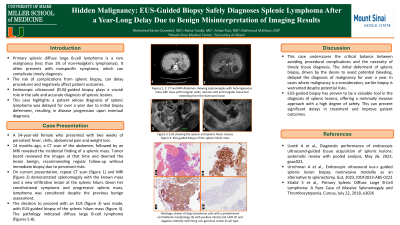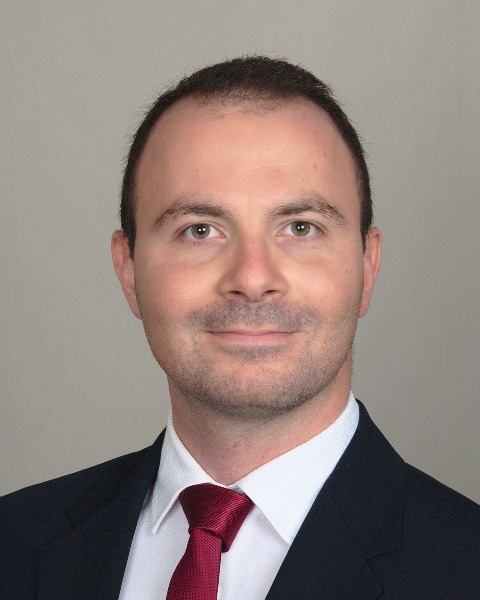Monday Poster Session
Category: Interventional Endoscopy
P2801 - Hidden Malignancy: EUS-Guided Biopsy Safely Diagnoses Splenic Lymphoma After a Year-Long Delay Due to Benign Misinterpretation of Imaging Results
Monday, October 28, 2024
10:30 AM - 4:00 PM ET
Location: Exhibit Hall E

Has Audio

Mohamed Karam Douedari, MD
Mount Sinai Medical Center
Miami Beach, FL
Presenting Author(s)
Mohamed Karam Douedari, MD1, Rama Tarakji, MD1, Felipe Ruiz, MD2, Mahmoud Mahfouz, MD3
1Mount Sinai Medical Center, Miami Beach, FL; 2University of Miami Miller School of Medicine at Jackson Memorial Hospital, Miami, FL; 3University of Miami Miller School of Medicine, Miami, FL
Introduction: Primary splenic diffuse large B-cell lymphoma is a rare malignancy, accounting for less than 1% of non-Hodgkin's lymphomas. It often presents with nonspecific symptoms, which can complicate timely diagnosis. While the risk of complications from splenic biopsy, particularly bleeding, can lead to deferred procedures, this delay can sometimes critically impact patient outcomes. Endoscopic ultrasound (EUS)-guided biopsy plays a crucial role in the safe and accurate diagnosis of splenic lesions. This case report highlights a patient whose diagnosis of splenic lymphoma was delayed for over a year due to initial biopsy deferment, resulting in disease progression upon eventual diagnosis.
Case Description/Methods: A 54-year-old female with a past medical history of a splenic lesion presented with persistent fever, chills, abdominal pain and weight loss over the preceding two weeks.
Regarding her splenic lesion, 14 months ago, a CT scan of the abdomen, followed by an MRI revealed the incidental finding of a splenic mass. Images reviewed by tumor board at that time deemed the lesion benign, recommending regular follow-up without immediate biopsy due to perceived risks.
On current presentation, repeat CT scan and MRI demonstrated splenomegaly with the known mass and a new infiltrative lesion at the splenic hilum. Initial differential diagnoses included infectious etiologies including abscess. However, given her constitutional symptoms and progressive splenic mass, lymphoma was considered despite the previous benign assessment. The decision to proceed with an EUS was made, with EUS-guided biopsy of the splenic hilum mass. The pathology indicated diffuse large B-cell lymphoma.
Discussion: This case underscores the critical balance between avoiding procedural complications and the necessity of timely tissue diagnosis. The initial deferment of splenic biopsy, driven by the desire to avoid potential bleeding, delayed the diagnosis of malignancy for over a year. In cases where malignancy is a consideration, earlier biopsy may be warranted despite potential risks. EUS-guided biopsy has proven to be a valuable tool in the diagnosis of splenic lesions, offering a minimally invasive approach with a high degree of safety. This can prevent significant delays in treatment and improve patient outcomes.
References:
Lisotti A et al., Diagnostic performance of endoscopic ultrasound-guided tissue acquisition of splenic lesions: systematic review with pooled analysis, May 26, 2022, Gastroenterol Rep (Oxf), goac022.

Disclosures:
Mohamed Karam Douedari, MD1, Rama Tarakji, MD1, Felipe Ruiz, MD2, Mahmoud Mahfouz, MD3. P2801 - Hidden Malignancy: EUS-Guided Biopsy Safely Diagnoses Splenic Lymphoma After a Year-Long Delay Due to Benign Misinterpretation of Imaging Results, ACG 2024 Annual Scientific Meeting Abstracts. Philadelphia, PA: American College of Gastroenterology.
1Mount Sinai Medical Center, Miami Beach, FL; 2University of Miami Miller School of Medicine at Jackson Memorial Hospital, Miami, FL; 3University of Miami Miller School of Medicine, Miami, FL
Introduction: Primary splenic diffuse large B-cell lymphoma is a rare malignancy, accounting for less than 1% of non-Hodgkin's lymphomas. It often presents with nonspecific symptoms, which can complicate timely diagnosis. While the risk of complications from splenic biopsy, particularly bleeding, can lead to deferred procedures, this delay can sometimes critically impact patient outcomes. Endoscopic ultrasound (EUS)-guided biopsy plays a crucial role in the safe and accurate diagnosis of splenic lesions. This case report highlights a patient whose diagnosis of splenic lymphoma was delayed for over a year due to initial biopsy deferment, resulting in disease progression upon eventual diagnosis.
Case Description/Methods: A 54-year-old female with a past medical history of a splenic lesion presented with persistent fever, chills, abdominal pain and weight loss over the preceding two weeks.
Regarding her splenic lesion, 14 months ago, a CT scan of the abdomen, followed by an MRI revealed the incidental finding of a splenic mass. Images reviewed by tumor board at that time deemed the lesion benign, recommending regular follow-up without immediate biopsy due to perceived risks.
On current presentation, repeat CT scan and MRI demonstrated splenomegaly with the known mass and a new infiltrative lesion at the splenic hilum. Initial differential diagnoses included infectious etiologies including abscess. However, given her constitutional symptoms and progressive splenic mass, lymphoma was considered despite the previous benign assessment. The decision to proceed with an EUS was made, with EUS-guided biopsy of the splenic hilum mass. The pathology indicated diffuse large B-cell lymphoma.
Discussion: This case underscores the critical balance between avoiding procedural complications and the necessity of timely tissue diagnosis. The initial deferment of splenic biopsy, driven by the desire to avoid potential bleeding, delayed the diagnosis of malignancy for over a year. In cases where malignancy is a consideration, earlier biopsy may be warranted despite potential risks. EUS-guided biopsy has proven to be a valuable tool in the diagnosis of splenic lesions, offering a minimally invasive approach with a high degree of safety. This can prevent significant delays in treatment and improve patient outcomes.
References:
Lisotti A et al., Diagnostic performance of endoscopic ultrasound-guided tissue acquisition of splenic lesions: systematic review with pooled analysis, May 26, 2022, Gastroenterol Rep (Oxf), goac022.

Figure: CT-Abdomen showing splenomegaly with heterogeneous hypodense mass and an infiltrative lesion at the splenic hilum (1). MRI-Abdomen showing splenic mass with irregular enhancing thickened walls, central necrosis, and multiple irregular tissue foci extending from the dominant lesion (2). Endoscopic ultrasound (EUS) showing the splenic mass, with a mass in the splenic hilum (3). EUS-guided biopsy of the splenic hilum mass (4). Histologic sections show sheets of large lymphoma cells with a predominant centroblastic morphology (5) (H&E; 200x), with positive cd3 (6) and cd20 (7) immunohistochemistry (IHC; 200x) and negative cd10 (8) (IHC;200x) confirming non-germinal center B-cell type.
Disclosures:
Mohamed Karam Douedari indicated no relevant financial relationships.
Rama Tarakji indicated no relevant financial relationships.
Felipe Ruiz indicated no relevant financial relationships.
Mahmoud Mahfouz indicated no relevant financial relationships.
Mohamed Karam Douedari, MD1, Rama Tarakji, MD1, Felipe Ruiz, MD2, Mahmoud Mahfouz, MD3. P2801 - Hidden Malignancy: EUS-Guided Biopsy Safely Diagnoses Splenic Lymphoma After a Year-Long Delay Due to Benign Misinterpretation of Imaging Results, ACG 2024 Annual Scientific Meeting Abstracts. Philadelphia, PA: American College of Gastroenterology.

